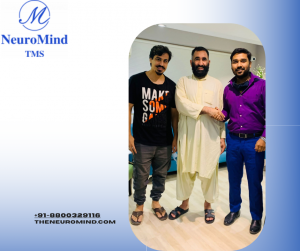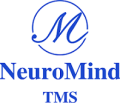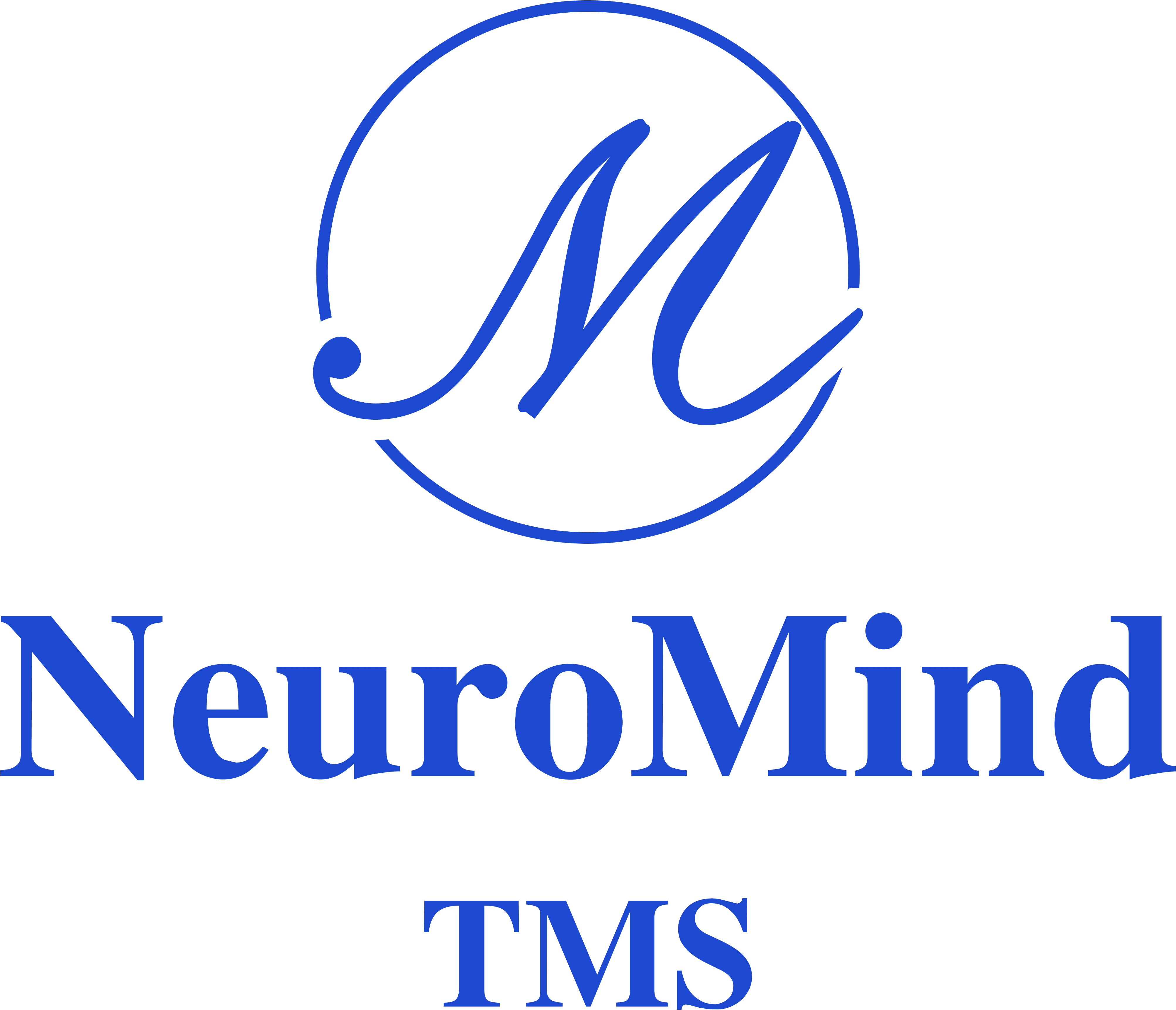Migraine Treatment by NeuroMind TMS
Migraine treatment using Transcranial Magnetic Stimulation (TMS) therapy is an innovative approach that aims to provide relief for individuals suffering from chronic migraines. TMS therapy utilizes magnetic fields to stimulate specific areas of the brain, modulating neural activity and potentially reducing the frequency and severity of migraines.
Diagnosis and Treatment Planning: Based on the assessment, the healthcare professional makes a diagnosis and develops an individualized treatment plan. This plan will determine the frequency and duration of TMS sessions, as well as any additional treatments or medications that may be recommended.
Transcranial Magnetic Stimulation (TMS) Therapy: TMS therapy involves the use of a specialized device that generates magnetic fields. These magnetic fields are targeted to specific areas of the brain, typically the prefrontal cortex, through a coil placed on the scalp. The coil emits brief pulses of magnetic energy, which pass through the skull and stimulate the underlying brain tissue.
Stimulation Parameters: The healthcare professional will determine the appropriate stimulation parameters for the individual’s specific migraine condition. This includes the intensity, frequency, and duration of the magnetic pulses. The parameters are adjusted to optimize treatment effectiveness while minimizing any potential side effects.
Treatment Sessions: TMS therapy for migraines typically involves multiple treatment sessions over several weeks. The sessions are usually conducted in an outpatient setting, and each session can last from 20 to 40 minutes. The exact number of sessions can vary depending on the individual’s response to treatment and the severity of their migraines.
Mechanism of Action: The precise mechanism by which TMS therapy provides relief for migraines is not yet fully understood. However, it is believed that magnetic stimulation modulates the abnormal brain activity associated with migraines, restoring a more balanced neural state and reducing the occurrence and intensity of migraines.
Potential Benefits: TMS therapy for migraines has shown promising results in clinical studies. It has the potential to reduce the frequency and severity of migraines, decrease the need for acute migraine medications, and improve the overall quality of life for individuals suffering from chronic migraines.
Neuro Psychiatry Treatment
Safety and Side Effects: TMS therapy is considered a safe procedure with minimal side effects. The most commonly reported side effect is mild scalp discomfort or tingling during the treatment session. These sensations are generally temporary and subside once the session is complete.
Integration with Other Treatments: TMS therapy can be used as a standalone treatment for migraines or as part of a comprehensive treatment plan. It may be combined with other therapies such as medication, lifestyle modifications, stress management techniques, and counseling, depending on the individual’s specific needs.
Long-Term Management: Migraine treatment using TMS therapy may provide long-lasting effects for some individuals. However, it is important to note that regular follow-up appointments and ongoing management are necessary to monitor the individual’s response to treatment and make any necessary adjustments.
Migraine: Affecting Daily Lives
A migraine is more than just a painful headache. At NeuroMind, we have a group of specialists who will help you cope with Migraine disorder and lead a happy life. It can cause intense throbbing pain or a pulsing sensation on one side of the brain. However, migraines are occasionally preceded by warning symptoms like nausea, vomiting, and sensitivity to light and sound. Migraine specialists at NeuroMind can assist you in managing your migraine signs & symptoms so that they do not take over your life. It causes intense agony that can persist for hours or days. Migraines can occur only once or twice a year or as frequently as daily. Women are more prone to experience migraines than males.
Is Every Headache a Migraine Pain?
Not every headache is a migraine pain. Migraine headaches typically begin between the ages of 10 and 45. Sometimes, they start earlier or later. The healthcare expert at NeuroMind can tell you whether a migraine disease or another issue causes your symptoms. Migraines may run in families. We offer services that will help you to prevent migraines from occurring. Migraines typically ache more on one side of the head.
Additionally, you may notice light sensitivity, aura, or bright lines or dots in your range of vision. People with severe migraine headaches may require emergency medical care. Migraines might occur infrequently or multiple times per month. A sinus headache is typically accompanied by pain and a runny or stuffy nose. Some people believe that an occasional headache is nothing to worry about. However, headaches can cause more severe problems.
Moreover, migraine headaches are a risk factor for strokes. Our services are available for you irrespective of your location. You can book an appointment 24 hours daily in case of any medical emergency.
Four Phrases of Migraine
A migraine attack can progress through stages. However, only some people suffer from each one. The four stages are:
Prodrome Phase: Prodrome phase is one or two days before the migraine severe pain. You may notice minor changes that warn of an impending migraine. Symptoms include mood fluctuations, food cravings, and neck stiffness. Doctors refer to the prodrome phase as the preheadache or premonitory phase.
Aura phase: Auras are sensory abnormalities before or during a migraine. Auras are reversible neurological symptoms. The aura phase might last up to 60 minutes. Auras can impair one’s vision, touch, or speech.
Headache phase: A migraine can continue for 4 to 72 hours if left untreated. This is when the pain typically strikes, ranging from minor to excruciating. Physical exertion and exposure to light, sound, and scents may exacerbate the pain. The pain can shift from one side of your head to the other, be at the front of your head, or seem like it’s spreading throughout your brain.
Postdromal phase: During this period, people may feel exhausted, bewildered, or sick. Some individuals may feel elated. The postdrome period usually lasts from a few hours to 48 hours. Symptoms resemble similar to an alcohol-induced hangover. Due to this reason, the postdrome phase is also referred to as a migraine hangover.
Diagnosis and Treating Migraine with NeuroMind TMS
At NeuroMind, we can diagnose your difficulty by asking about your symptoms and family history of migraines and try to provide migraine headache relief. Migraine headache treatment has no specific remedy. Our goal is to manage your migraine signs & symptoms as soon as possible while also preventing them by avoiding or modifying your triggers.
At NeuroMind, we have newer gadgets that deliver various types of nerve stimulation or magnetic stimulation that are also being tested for the treatment of migraines.
If your tension headaches are chronic or ongoing, make an appointment at NeuroMind. There are also other non-medical remedies available to help reduce migraine pain and frequency. One is an FDA-approved Transcranial Magnetic Stimulation (TMS) therapy. With this therapy for migraine headaches, we aim to help you feel more in control of your migraines.
TMS can currently be used to diagnose a wide range of conditions, including multiple sclerosis, movement disorders, stroke, and epilepsy. According to the specific migraine conditions of individuals, appropriate stimulation parameters are set by NeuroMind’s professionals. Depending on the individual, the therapy may involve various sessions over some weeks. However, each session of TMS at NeuroMind could last up to 20-40 minutes.
NeuroMind’s TMS Therapy for migraine pain
Neuroregulation devices, such as transcranial magnetic stimulation (TMS), are widely recognized as best migraine treatment medications. TMS is a procedure that uses short magnetic pulses on the head to stimulate brain tissue beneath to relieve migraine pain. Chronic migraines occur when a person experiences 15 or more days of symptoms per month. This can be debilitating for migraine sufferers, lowering their quality of life. Symptoms resemble an alcohol-induced hangover.
NeuroMind’s TMS (Transcranial Magnetic Stimulation) therapy may lessen migraine frequency and duration and help in proper migraine management. TMS sends painless magnetic pulses to your scalp. The theory is that those pulses can alter how your brain functions to assist you in various ways.
TMS also reduces migraine severity. TMS is a noninvasive technique, with the first transcranial magnetic stimulator (TMS) brought to the world in 1984-1985. TMS has been shown to alleviate a variety of diseases, including mental disorders (depression, acute mania, schizophrenia, bipolar disease, panic disorder, post-traumatic stress disorder, substance misuse) and neurologic disorders (Parkinson’s disease, dystonia, tinnitus, epilepsy, stroke, etc).
The healthcare expert at NeuroMind TMS determines migraine diagnosis and creates a personalized treatment plan based on the examination. This plan will specify the frequency and duration of TMS sessions and any additional treatments or drugs that may be prescribed.
How Safe is TMS Therapy for Migraine?
If you have chronic migraine symptoms and haven’t found relief from medicine for migraine pain or other migraine treatments, consult NeuroMind about TMS as soon as possible. Clinical investigations suggest that TMS could be a helpful migraine prevention therapy. However, this therapy is clinically proven safe. Talk to Neuromind to see if TMS is correct for you. If you wish to use fewer pain relievers to avoid medication for migraine headaches, or if you want to avoid medications for other reasons, consider Neuromind’s TMS.
TMS or transcranial magnetic stimulation is not suggested for persons who have seizures or epilepsy or for anyone who has other current medical problems that increase the risk of seizures. TMS may also be a proper alternate treatment for some fibromyalgia symptoms. The success of this treatment varies according to the disease and the physician.
Side effects during and after TMS treatments are usually mild but might occur. Approximately one-third of persons experience headache pain or facial twitching during this therapy. Most people who try TMS have no problems or experience any adverse effects.
As TMS uses magnetic pulses, you must remove all jewelry and metal from your body or clothing before beginning treatment. For the same reason, if you have any metal implants in your head, you may be unable to receive TMS therapy.
Why live a painful life when NeuroMind TMS therapy can help you out? Book your appointment and say goodbye to migraine headaches.
Video Testimonials by Patient
Testimonials by Patient










With access to
24 Hour
APPOINTMENT
Assistance
Our 24-hour appointment is available for everyone whenever urgent situations arise. Get essential care even during evenings, weekends, holidays, or other non-standard times.



